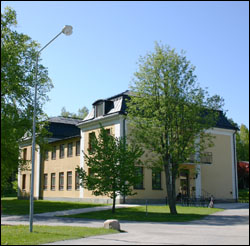University of Gävle
University of Gävle

Generally
In order to obtain good air quality in the premises, the ventilation is adapted to the number of people and the equipment planned for the rooms. To provide heat and prevent frostbite, there are radiators located along facade walls.
Office
The air supply in offices takes place automatically with a continuous flow.
Conference room
Demand-controlled ventilation for the number of people the room is planned for.
Car parking
Parking spaces intended for vehicles with a handicap permit can be found close to the main entrance. Please see Campus map .
Entrances and lifts
The entrances are accessible and all floors can be reached via lift.
RWC
Toilets adapted for the disabled are available on each floor. At the RWC there are security alarms with red push buttons labeled "emergency signal". Alarms are indicated locally by sound and a red flashing light outside each room. It is important that you who see and hear this alarm contact the person concerned who needs help. Alarms are reset inside each room by pressing the reset button.
See more information about physical accessibility on campus .
SCARED - WARN - ALARM - EXTINGUISH
• save yourself and others around you, but don't take too many risks yourself
• warn others who may be in danger
• alert the Emergency Services by calling 112
• put out the fire if possible
Automatic fire alarm
Evacuation alarms in case of fire are triggered via smoke detectors placed in escape routes, technical spaces and in spaces where many people gather. Triggered alarm, i.e. signal to evacuate, given via bell.
Triggered alarms go to SOS Alarm and Akademiska Hus. Fires that cannot be extinguished with deployed hand fire extinguishers must be alerted via telephone 112. Limit the source of the fire by closing windows and doors.
You can manually trigger the evacuation alarm using push buttons in connection with the escape routes.
Fire cells
The building is divided into a number of fire cells to prevent fire and smoke from spreading.
Each fire cell is delimited by fire-rated walls and doors. In principle, all floors, stairwells, lifts, operating areas and waste rooms have their own fire cells. Doors in fire compartment boundaries can be set in the open position for transport with magnetic suspension and closed manually with a push button labeled "fire door closer". When an evacuation alarm is triggered, the doors close automatically within the alarmed area.
Doors in fire compartment boundaries must absolutely not be blocked by wedges or the like!
Escape routes / Assembly point
See evacuation plans in corridors.
The stairwells form independent escape routes. Two stairwells can be reached from each workplace. The escape routes, which are marked with green luminous escape signs, must never be blocked. The green signs are always lit and have a battery backup to illuminate even in the event of a power cut.
If the fire alarm is triggered, all personnel must leave the building, close all doors behind them and gather at the assembly point (See the respective evacuation plan). The staff reports there to the evacuation recipient and leaves their name and group affiliation or equivalent. No one may depart from the assembly point until this is done.
Public areas
In stairwells and corridors, the lighting is controlled automatically via time channel and demand control. After a set time, the lighting can be turned on manually via a push button and in certain areas via a presence detector. Some lighting is switched on after regular office hours, so-called led lighting. Some of the WC and storage areas are switched on and off automatically via presence detectors.
Office
In offices, the lighting is turned on and off manually via a push button inside the door.
The University of Gävle itself takes care of the waste management relating to the University's internal environments.
Outside, there are many trash cans that are emptied and taken care of by Akademiska Hus.
The tenant is responsible for removing bulky waste, pallets and packaging.